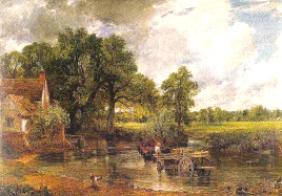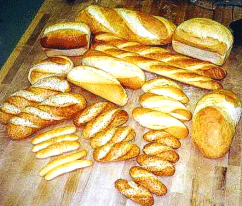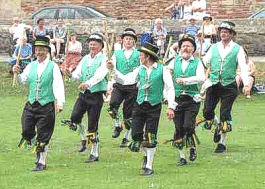Controverscial.Com
![]()
Welcome
![]()
|
Controverscial.Com
Welcome
|
|
|
Controverscial.Com
Welcome
|



Sabbats in History and Mythology / Samhain (October 31st) / Yule (December 21st) / Imbolc (February 2nd) / Ostara (March 21st) / Beltane (April 30th) / Litha (June 21st) / Lughnasadh (August 1st) / Mabon (September 21st)

The Hay Wain
by John Constable (1821)
Lammas is one of the greater Sabbats of the Witches calendar and in the
Northern Hemisphere
is celebrated on the 1st August (in the Southern Hemisphere the equivalent Sabbat is Imbolc).
Traditionally Lammas is a
celebration of the first fruits and first corn harvest of the
year, when as a result of the union between the Goddess and God the land gives
up its bounty. As summer turns to
autumn and the plantings from spring begin to wither and die, they drop their
produce for our use and seeds for a future harvest.
In the mythology of the Sabbats as daylight decreases and nights grow longer, God grows old and his strength becomes weaker. The Goddess looks on in sorrow and watches God dying, but knows he lives on inside her, a child to be re-born again at Yule in the never-ending cycle of life, death and re-birth.
Lammas is commonly known by several other names: Lughnasadh (named for the Celtic sun god Lugh), August Eve, Feast of Bread and Harvest Home. The name Lammas comes from an old Christianised Saxon term “hlaf maesse” meaning “loaf mass”, which reflects the importance of bread at this time. When Christianity arrived many Pagan traditions were incorporated and adapted for use in their churches. One such was Lammas. On the first Sunday of August homegrown produce and baskets of fruit were donated to local churches, and loaves of bread made from the first corn harvest placed on the alter to be blessed and consecrated. After the service the food was distributed among the old folk and the homeless, or given to hospitals and other charitable organisations.

Common
bread products
Lammas is the first of three autumnal festivals each year, the others
being Mabon (21st Sept) and Samhain (31st Oct).
Corn, grain and barley, including
wheat
in the UK, oats
in Scotland and Ireland, and maize in the USA, as well as fruit,
berries and grapes, are all crops harvested at this time of the year.
As bread was one of the main staple diets of our
ancestors, and with the
success of the harvest being so important to the survival of the people,
so the preparation and making of the first loaves of breads was often followed
by ceremonies and
sacrificial offerings to ensure the re-growth of crops for the following
year.
While the hottest days of summer are still upon
us and temperatures remain high, the climate slowly changes as we enter the
harvest time. Each day as the shadows
grow longer, squirrels and other small animals of the woods get busy gathering
and storing food for the winter to come. Likewise
for the people, this was a time to start canning and preserving goods ready to
sustain them while the land recovers and nature sleeps.

Harvesting a field of wheat
In some traditions Corn dollies would be made from the last cut sheaves of corn and fashioned into stick like figures representative of the “Spirit of the Corn”. These would be used as attractive table decorations at banquets and feasts, then saved until the following spring. Many believed that with the cutting of the last sheaves of corn, the “Spirit of the Corn” retreated into the soil, there to sleep throughout the winter. At the start of the new planting season, the Corn Dollies would be returned to the fields, burned and mixed with the new seed being ploughed into the ground. It was hoped that the “Spirit of the Corn” would then awaken and ensure the next harvest.
After the labour intensive work of bringing in the harvest, then preserving, packing and storing enough stocks to last through winter, it was time to relax and take a break. Lammas was traditionally a time for family re-unions, and a perfect time to arrange handfastings (marriages) aimed at strengthening links and alliances with neighbouring clans and their families. With the prosperity afforded by a successful harvest, many attended Markets, Craft Fairs and Festivals to show off their wares and party.
During the day Marching bands and Morris dancers led parades around the villages followed by giant effigies of “John Barleycorn”, the “Green Man” or the “Wicker Man”. Younger members of the family would compete in games designed to show off skills needed for working farms and raising livestock, thus proving their abilities to provide food, shelter and protection. Women folk also competed showing off their skills in cooking and sewing, hoping to impress prospective mates.

Morris Dancers
The highlight of many such festivals was the lighting of a bonfire in tribute to the fading powers of the Sun, during which the giant effigies paraded earlier would be burned in a symbolic sacrifice of the Corn King. To finish the celebrations a large wagon wheel (Catherine wheel) would be taken to the top of a near-by hill, smeared with tar and set alight, then ceremoniously rolled down the hill in a representation of the Sun’s decline into the autumn of its year. Remnants from the bonfire would later be taken home and kept throughout the winter as protection against storms and fires caused by lightning.
In
Celtic mythology Tailtiu
was a revered Goddess of the Land, the last
Queen or chieftain of the Fir Bolg who had been defeated during the invasion of
the Tuatha de Danaan. After
the invasion Tailtiu was placed in
bondage and became the surrogate foster-mother of Lugh.
But shortly after the invasion her people suffered a bad harvest, and
famine spread quickly throughout the lands.
Seeing her people suffering Tailtiu took up an axe and began to clear a
great forest, by doing so she enabled the
land to be re-cultivated and planted
with grain, the harvest of which saved the people from starvation.
However the effort put too great a strain on Tailtiu’s heart and she died
from exhaustion. Lugh
then instituted the “Óenach Tailtenn“ or “Tailtiu Games” in
her honour at the festival of Lughnasadh in August.
As a favoured chieftain of the Tuatha de Danaan, Lugh’s festival quickly evolved into an annual gathering of the clans and tribes, which was attended by all their major chieftains. Peace reigned over the games while assembles were held and differences discussed, laws passed and handfastings/marriages arranged in efforts to strengthen alliances. A feature of the festival was sporting prowess, and competitions were held to test the courage, strength and skill in battle of the competitors.
Held on the 1st of August the date of his foster-mothers death after her battle with the land and the first harvest. The common people ascended on the games to trade and display their wares, to sell food, animals, crafts and clothing. Actor’s re-enacted the Tailtiu drama and Bards told their stories, musicians played music while singers sang and dancers danced, and everyone else joined in and made merry.
The old town of Tailtiu (now Teltown, between Navan and Kells) in County Meath was named in her honour, and is where the festival of Lughnassadh was traditionally held in early times. The Lughnasadh games continue to be celebrated in Ireland, but more today in recognition of the skills needed to raise livestock and farm a successful harvest.Microsoft®
Encarta® 2006. © 1993-2005 Microsoft Corporation. All rights reserved.
Cunningham's Encyclopedia Of Magical Herbs - By Scott Cunningham
A Witches Bible - by Stewart and Janet Farrar
http://www.moonshadows-realm.co.uk/sab-lammas.htm
http://www.mythicalireland.com/mythology/index.html
Plus others to many too mention
Written and compiled on the 04th July 2008 © George Knowles
![]()
![]()

Let there be peace in the world - Where have all the flowers gone?
My Personal Page / My Place in England, UK / My Family Tree (Ancestry)
Wicca/Witchcraft / What is Wicca / What is Magick
Traditional Writings:
Wiccan Rede / Charge of the Goddess / Charge of the God / The Three-Fold Law (includes The Law of Power and The Four Powers of the Magus) / The Witches Chant / The Witches Creed / Descent of the Goddess / Drawing Down the Moon / The Great Rite Invocation / Invocation of the Horned God / The 13 Principles of Wiccan Belief / The Witches Rede of Chivalry / A Pledge to Pagan Spirituality
Correspondence Tables:
Incense / Candles / Colours / Magickal Days / Stones and Gems / Elements and Elementals
Traditions Part 1 - Alexandrian Wicca / Aquarian Tabernacle Church (ATC) / Ár Ndraíocht Féin (ADF) / Blue Star Wicca / British Traditional (Druidic Witchcraft) / Celtic Wicca / Ceremonial Magic / Chaos Magic / Church and School of Wicca / Circle Sanctuary / Covenant of the Goddess (COG) / Covenant of Unitarian Universalist Pagans (CUUPS) / Cyber Wicca / Dianic Wicca / Eclectic Wicca / Feri Wicca /
Traditions Part 2 - Gardnerian Wicca / Georgian Tradition / Henge of Keltria / Hereditary Witchcraft / Hermetic Order of the Golden Dawn (H.O.G.D.) / Kitchen Witch (Hedge Witch) / Minoan Brotherhood and Minoan Sisterhood Tradition / Nordic Paganism / Pagan Federation / Pectic-Wita / Seax-Wica / Shamanism / Solitary / Strega / Sylvan Tradition / Vodoun or Voodoo / Witches League of Public Awareness (WLPA) /
Gods and Goddesses (Greek
Mythology) / Esbats &
Full Moons / Links
to Personal Friends & Resources / Wicca/Witchcraft
Resources / What's a spell? /
Circle Casting and
Sacred Space / Pentagram
- Pentacle / Marks
of a Witch / The Witches
Power / The Witches Hat
/ An
esoteric guide to visiting London / Satanism
/ Pow-wow
/ The
Unitarian Universalist Association / Numerology: Part 1
/ Part 2 / Part
3 / A
history of the Malleus Maleficarum: includes: Pope
Innocent VIII /
The
papal Bull /
The
Malleus Maleficarum /
An extract from the Malleus Maleficarum
/ The letter of approbation
/ Johann
Nider’s Formicarius /
Jacob
Sprenger /
Heinrich Kramer /
Stefano Infessura
/ Montague Summers /
The Waldenses
/ The Albigenses
/
The Hussites / The
Sun Dance
/ Shielding (Occult
and Psychic Protection) /
Sabbats in History and Mythology / Samhain (October 31st) / Yule (December 21st) / Imbolc (February 2nd) / Ostara (March 21st) / Beltane (April 30th) / Litha (June 21st) / Lughnasadh (August 1st) / Mabon (September 21st)
Rituals contributed by Crone: Samhain / Yule / Imbolc / Ostara / Beltane / Litha / Lammas / Mabon
Tools of a Witch / The Besom (Broom) / Poppets and Dolls / Pendulums / Cauldron Magick / Mirror Gazing
Animals in Witchcraft (The Witches Familiar) / Antelope / Bats / Crow / Fox / Frog and Toads / Goat / Honeybee / Kangaroo / Lion / Owl / Phoenix / Rabbits and Hares / Raven / Robin Redbreast / Sheep / Spider / Squirrel / Swans / Wild Boar / Wolf / Serpent / Pig / Stag / Horse / Mouse / Cat
In Worship of Trees - Myths, Lore and the Celtic Tree Calendar. For descriptions and correspondences of the thirteen sacred trees of Wicca/Witchcraft see the following: Birch / Rowan / Ash / Alder / Willow / Hawthorn / Oak / Holly / Hazel / Vine / Ivy / Reed / Elder. Also see: The Willow Tree (Folk Music)
Mystical Sacred Sites - Stonehenge / Glastonbury Tor / Malta - The Hypogeum of Hal Saflieni / Avebury / Cerne Abbas - The Chalk Giant / Ireland - Newgrange /
Rocks and Stones:
Stones - History, Myths and Lore
Articles contributed by Patricia Jean Martin: / Apophyllite / Amber / Amethyst / Aquamarine / Aragonite / Aventurine / Black Tourmaline / Bloodstone / Calcite / Carnelian / Celestite / Citrine / Chrysanthemum Stone / Diamond / Emerald / Fluorite / Garnet / Hematite / Herkimer Diamond / Labradorite / Lapis Lazuli / Malachite / Moonstone / Obsidian / Opal / Pyrite / Quartz (Rock Crystal) / Rose Quartz / Ruby / Selenite / Seraphinite / Silver and Gold / Smoky Quartz / Sodalite / Sunstone / Thunderegg / Tree Agate / Zebra Marble
Wisdom:
Knowledge vs Wisdom by Ardriana Cahill / I Talk to the Trees / Awakening / The Witch in You / A Tale of the Woods
Articles and Stories about Witchcraft:
Murder by Witchcraft / The Fairy Witch of Clonmel / A Battleship, U-boat, and a Witch / The Troll-Tear (A story for Children) / Goody Hawkins - The Wise Goodwife / The Story of Jack-O-Lantern / The Murder of the Hammersmith Ghost / Josephine Gray (The Infamous Black Widow) / The Two Brothers - Light and Dark
Old Masters of Academia:
Pliny the Elder / Hesiod / Pythagoras
Abramelin the Mage / Agrippa / Aidan A. Kelly / Albertus Magnus “Albert the Great” / Aleister Crowley “The Great Beast” / Alex Sanders "the King of the Witches” / Alison Harlow / Amber K / Anna Franklin / Anodea Judith / Anton Szandor LaVey / Arnold Crowther / Arthur Edward Waite / Austin Osman Spare / Biddy Early / Bridget Cleary / Carl Llewellyn Weschcke / Cecil Hugh Williamson / Charles Godfrey Leland / Charles Walton / Christina Oakley Harrington / Damh the Bard (Dave Smith) / Dion Fortune / Dolores Aschroft-Nowicki / Dorothy Morrison / Doreen Valiente / Edward Fitch / Eleanor Ray Bone “Matriarch of British Witchcraft” / Dr. John Dee and Edward Kelly / Dr. Leo Louis Martello / Eliphas Levi / Ernest Thompson Seton / Ernest Westlake and the Order of Woodcraft Chivalry / Fiona Horne / Friedrich von Spee / Francis Barrett / Gerald B. Gardner / Gavin and Yvonne Frost and the School and Church of Wicca / Gwydion Pendderwen / Hans Holzer / Helen Duncan / Herman Slater "Horrible Herman" / Israel Regardie / James "Cunning" Murrell / Janet Farrar & Gavin Bone / Jessie Wicker Bell “Lady Sheba” / John Belham-Payne / John George Hohman / John Gerard / John Gordon Hargrave (the White Fox) / John Michael Greer / John Score / Johannes Junius the Burgomaster of Bamberg / Joseph John Campbell / Karl von Eckartshausen / Laurie Cabot "the Official Witch of Salem" / Lewis Spence / Margaret Alice Murray / Margot Adler / Marie Laveau the " Voodoo Queen of New Orleans" / Marion Weinstein / Matthew Hopkins “The Witch-Finder General” / Max Ehrmann and the Desiderata / Monique Wilson the “Queen of the Witches” / Montague Summers / Nicholas Culpeper / Nicholas Remy / M. R. Sellers / Mrs. Grieve "A Modern Herbal" / Oberon and Morning Glory Zell-Ravenheart / Old Dorothy Clutterbuck / Old George Pickingill / Paddy Slade / Pamela Colman-Smith / Paracelsus / Patricia Crowther / Patricia Monaghan / Patricia “Trish” Telesco / Philip Emmons Isaac Bonewits / Philip Heselton / Raymond Buckland / Reginald Scot / Robert Cochrane / Robert ‘von Ranke’ Graves and "The White Goddess" /
Rudolf Steiner / Rosaleen Norton “The Witch of Kings Cross” / Ross Nichols and The Order of Bards, Ovates & Druids / Sabrina - The Ink Witch / Scott Cunningham / Selena Fox / Silver Ravenwolf / Sir Francis Dashwood / Sir James George Frazer / S.L. MacGregor Mathers and the “Hermetic Order of the Golden Dawn” / Starhawk / Stewart Farrar / Sybil Leek / Ted Andrews / The Mather Family - includes: Richard Mather, Increase Mather, Cotton Mather / Thomas Ady / Vera Chapman / Victor Henry Anderson / Vivianne Crowley / Walter Brown Gibson / William Butler Yeats / Zsuzsanna Budapest
Many of the above biographies are brief and far from complete. If you know about any of these individuals and can help with aditional information, please cantact me privately at my email address below. Many thanks for reading :-)
While I have taken due care and dilligence to credit all sources where possible, this website may contain copyrighted material which has not been specifically authorized by the copyright owner. My use of making such material available here is done so in my efforts to advance our understanding of religious discrimination, the environmental and social justice issues etc. If you wish to use copyrighted material from this wedsite for purposes of your own then you must obtain permission from the relevant copyright owner yourself.
![]()
My online email discussion group:
http://groups.yahoo.com/group/Email_Witches

Help send a message of peace around the world! The Dove of Peace flies from site to site, through as many countries as possible. It does not belong to ANY belief system. Please help make a line around the globe by taking it with you to your site, by giving it to someone for their site, by passing it on to another continent or to the conflict areas of the world. May trouble and strife be vanquished in it's path.

mailto:George@controverscial.com
![]()
|
|